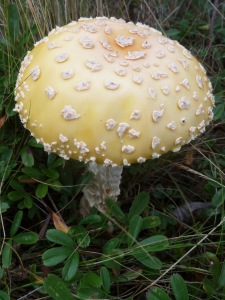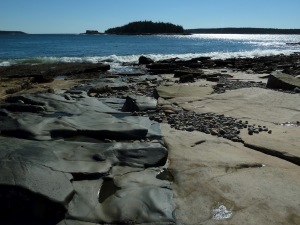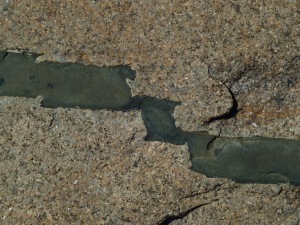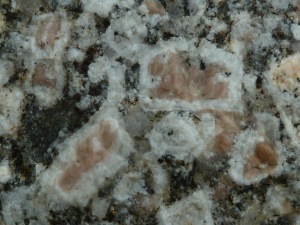 |
| Plagioclase mantling alkali feldspar |
Also seen throughout the Deer Isle granite is significant mingling of felsic and mafic magmas and composite dikes. These composite dikes are most interesting in that they preserve different generations of dike generation often alternating between felsic and mafic melts and although this intrusion suite was emplaced in a relatively short time frame (thousands of years?) these dikes have relatively sharp edges implying the viscosity of the surrounding magma was high enough not to allow significant mixing.
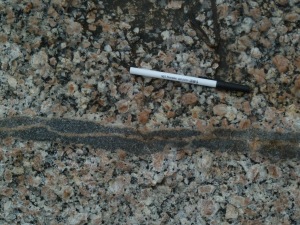 |
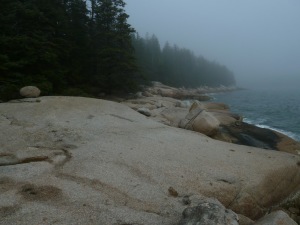 |
| Small composite dike | Geology in Maine is only to be had along the coast |
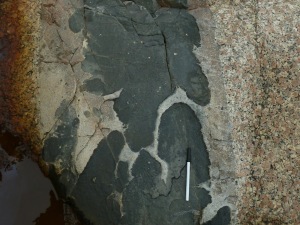 |
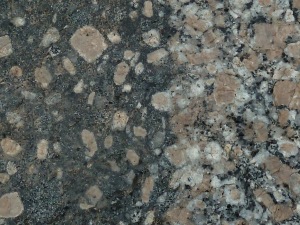 |
| Larger complex composite dike | Magma mingling and mixing of mantled feldspars |
Moving up the pluton, the large rapakivi feldspars and mafic enclaves disappear as we leave the cumulate pile. Replacing them are abundant ladder dike schlieren (layers of elongate concentrations of mafic minerals) and pods of quartz syenite. Fe content of the alkali feldspars also decreases as you move up in the pluton (indicated by the paling upwards in the color of the feldspar — red to pink/white).
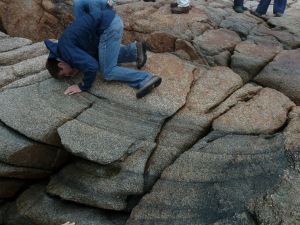 |
 |
| Classic geologist pose (Austin Boles) with ladder dike schlieren |
Close-up of schlieren |
 |
| Larry the 4 pound Lobster |
The next stop on my trip was to the Gouldsboro Pluton. The Gouldsboro pluton is a Devonian age bimodal system that is best exposed on the Schoodic Peninsula northeast of Mount Desert Island. The Gouldsboro pluton can be internally divided into several major units based on both composition and textural features. Similar to the Deer Isle granite, the Gouldsboro pluton shows clear evidence of mafic-felsic interaction near base and transitions to miarolitic cavity rich and more evolved granite near the top. Also at the base of the pluton is a large “scatter zone” of the country rocks the Gouldsboro intuded.
 |
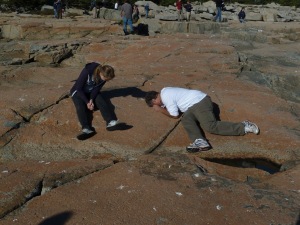 |
| Miarolitic cavities occur throughout the Gouldsboro | Another clastic geologist pose (Mike Dorais and Tara Allen) on the Gouldsboro pluton (note: white spots are bird poop and not geology) |
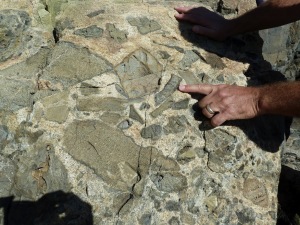 |
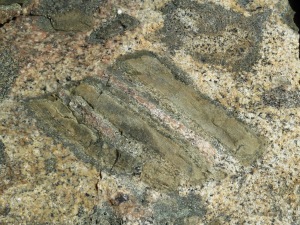 |
| Shatter zone at the base of the Gouldsboro pluton | Schist xenolith with granite intruding along foliations |
While at the Gouldsboro pluton, my fellow field trippers also stopped to look at the the dikes associated with the Central Atlantic Magmatic Province. The Central Atlantic Magmatic Province is a large group of basalt dikes, sills, and lava flows formed at the beginning of the breakup of Pangaea.
The CAMP is a very important province in the debate of whether the breakup of Pangea was controlled by a emplacement of a large mantle plume. Some researchers have presented geochemical data suggesting that magmas generated in the CAMP province display signatures indicative of a deep mantle source (i.e. mantle plume). This deep mantle source of CAMP is at stark contrast to that which resembles oldest mid-ocean ridge basalts in the Atlantic Ocean. These researchers show the plume-signature of the CAMP magmas is found near the center of CAMP magmatism and decreases away from the center of paleo-plume.
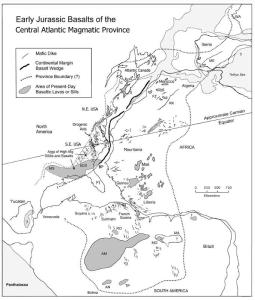 |
| Map of CAMP (from Auburn University) |
This however, is not the only viewpoint. The folks over at MantlePlumes.org claim there is a significant absence of features presumably required by a deep-mantle plumes. There is no circular uplift associated with the emplacement of a plume, nor evidence of a plume tail of Jurassic alkaline volcanic seamounts as commonly seen along other “mantle plumes” (i.e. Tristan de Cunha and Hawaii). Furthermore, they claim the supposed deep mantle signature presumes that mantle reservoirs are only found in the deep mantle. They site several recent studies that have presented convincing arguments to support upper mantle sources for similar components. Although this ‘camp’ is does not give universally accepted explanations for the New England seamounts (a supposed hotspot track), nor the radiating pattern of the dikes surrounding the presumed plume center.
It is because of places like CAMP that debates of plumophiles and plumoclasts will never end. Good times.
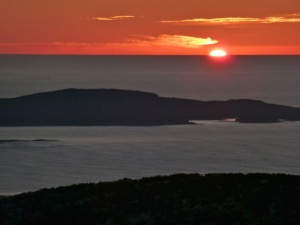 |
| Sunrise from Mount Desert (the first place in the United States to see the sun) |
![]() This work is licensed under a Creative Commons Attribution-NonCommercial-ShareAlike 4.0 International License.
This work is licensed under a Creative Commons Attribution-NonCommercial-ShareAlike 4.0 International License.



